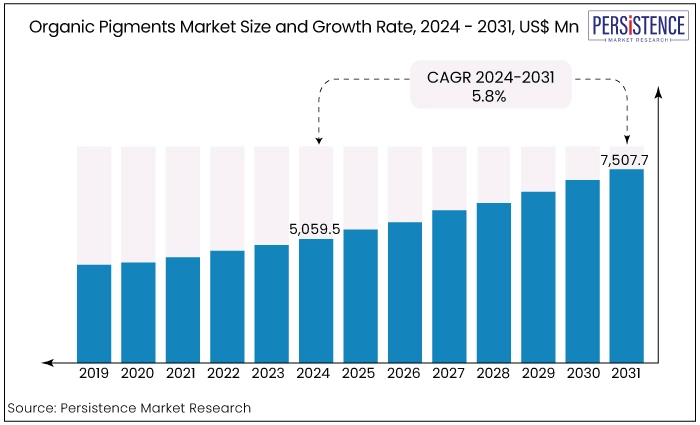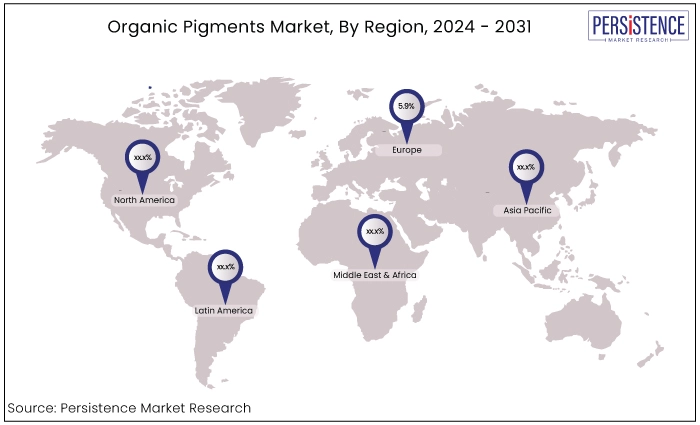Organic Pigments Market
Industry: Chemicals and Materials
Published Date: August-2024
Format: PPT*, PDF, EXCEL
Delivery Timelines: Contact Sales
Number of Pages: 173
Report ID: PMRREP34741
The global organic pigments market is anticipated to reach a value of US$7,507.7 Mn by the end of 2031 up from US$5,059.5 Mn in 2024. This growth reflects an expected CAGR of 5.8% from 2024 to 2031.
Key Highlights of the Market
|
Market Attributes |
Key Insights |
|
Market Size (2024E) |
US$5,059.5 Mn |
|
Projected Market Value (2031F) |
US$7,507.7 Mn |
|
Global Market Growth Rate (CAGR 2024 to 2031) |
5.8% |
|
Historical Market Growth Rate (CAGR 2019 to 2023) |
4.4% |

|
Region |
Projected CAGR through 2031 |
|
Europe |
5.9% |
The organic pigments market in Europe is the second largest globally, holding around 20% of the market share, following North America. This significant market position is largely driven by key industries in the region, including automotive, building and construction, and packaging. These sectors are leading consumers of plastics, which in turn drives up the demand for organic pigments used in various applications.
The paints and coatings sectors within the building and construction and automotive industries are significant consumers of organic pigments. The demand for high-quality pigments is substantial in these areas due to their critical role in providing vibrant and durable finishes.
Key countries within Europe, such as Germany and the United Kingdom, are leading players in the market. These nations exhibit strong growth potential, primarily due to the increasing application of organic pigments in automotive paints and coatings. As these industries continue to expand and innovate, the demand for advanced organic pigments in Europe is expected to rise.

|
Category |
Projected CAGR through 2031 |
|
Source- Natural |
6.4% |
Natural organic pigments category is anticipated to exhibit the annual growth of 6.4 % through 2031. These pigments are favourable for environment sustainability which makes it an important market driver. These pigments are gaining traction due to increasing consumer and industry preference for sustainable and environment-friendly products.
Natural pigments, sourced from fruits, vegetables, flowers, and other natural elements, are celebrated for their eco-friendly credentials. Natural pigments are often biodegradable and have a smaller environmental footprint. This shift toward natural pigments aligns with global trends towards reducing chemical pollution and supporting environmentally responsible practices.
As consumers and businesses become environmentally conscious, the demand for natural pigments has increased making them a popular choice across several industries including textiles, food and beverages, and cosmetics.
|
Category |
Projected CAGR through 2031 |
|
Type - HPP |
6.2% |
The high-performance pigment (HPP) segment holds a prominent position in the organic pigments market due to its advanced characteristics compared to traditional pigments. HPPs provide exceptional colour strength and intensity even in small quantities, making them ideal for applications requiring high visual impact, such as premium automotive coatings and packaging.
HPPs are also known for their superior durability, including enhanced lightfastness to resist fading from sunlight, and increased resistance to heat, chemicals, and solvents. These properties render HPPs particularly suitable for demanding environments, such as outdoor coatings and industrial products that require long-lasting performance and stability.
The development and use of HPPs involve advanced research and technological innovation. Manufacturers invest significantly in research and development to create pigments with specific performance properties that meet the needs of specialized applications. For instance,
|
Category |
Projected CAGR through 2031 |
|
Application - Paints and Coatings |
6.0% |
The paint and coating application segment contributes with a major share of 35% to the organic pigments market. This segment encompasses a wide range of applications, from residential and commercial paints to industrial coatings and automotive finishes.
Organic pigments are valued for their vivid colours, which enhance the visual appeal of painted surfaces. The organic pigments are also used in appliances with opacity and brightness. These pigments offer a wide range of kinds enabling manufacturers to fulfil varied design and branding requirements.
The organic pigments are also used as coatings to provide functional benefits. High- performance coatings often use organic pigments to achieve attributes UV resistance and higher durability.
The segment also includes specialty coatings used in industrial and automotive settings offering visually striking and durable, resisting environmental wear and tear. In industrial coatings, pigments contribute to both the aesthetic qualities and the protective functions of the coatings, such as corrosion resistance or heat resistance.
The global organic pigments market is rising with moderate growth rate of 5.8 % CAGR. This growth is primarily driven by the increasing applications of organic pigments in the printing ink and paints & coatings industries.
Organic pigments, sourced from natural materials like plants and microorganisms, are increasingly favoured for their reduced environmental impact compared to synthetic alternatives. They offer excellent colour strength and durability while supporting sustainability goals, making them popular in industries such as automotive, construction, and textiles.
The expanding use of these pigments across various coating applications such as decorative, industrial, construction, automotive, and packaging fuels the market's expansion. The emerging regions such as Asia Pacific and Africa are demanding for organic pigments due to increasing construction and textile market.
Organic pigments, known for their brightness, quality, and strength, are gaining traction in the textile sector as colorants. These pigments, composed of both organic and inorganic substances utilize technologies such as absorption and light scattering to alter the appearance of substrates to which they are applied.
Produced from natural sources like plants and animals and from carbon compounds, organic pigments are typically available in powdered form. This form is used for colouring a wide range of products including those in the performing arts.
The historical performance of the organic pigments market has demonstrated consistent stability, with a CAGR of 4.4 % despite facing various challenges. The global organic pigment market experienced a decline of around 15% due to reduced demand in the Western market, which faced challenges such as sudden inflation and supply chain disruptions.
Following adjustments in regulations and industry strategies, the market has begun to recover. This recovery has been driven by increased demand in the paints and coatings sector, as well as in the food and beverage industry.
During the forecast period from 2024 to 2031, the organic pigment market is anticipated to experience moderate growth, with an estimated CAGR of 5.8 %. This growth is expected to result in a substantial absolute dollar opportunity, around valued at US$ 2,448.2 Mn.
In recent years, the demand for eco-friendly pigments in various industries such as paint and coatings in automotive, construction, food and beverages are rising. North America and Europe are demanding environmental solutions on various industries including paints and coatings. These regions have a significant share in organic pigments market and it is estimated to grow more in the forecast period.
Rising Demand for Environment-Friendly Pigments
Several growing end use industries such as consumer goods, automotive, and construction prefer the environmentally sustainable pigment solutions. These industries rely on pigments for various applications, including vibrant and durable automotive finishes, high-performance coatings for buildings, and visually appealing packaging materials. As these sectors grow, they drive the need for advanced pigment solutions that can meet their evolving requirements.
Consumers are also becoming more environmentally conscious and are increasingly favouring products made from sustainable and non-toxic materials. This shift is mirrored by stringent environmental regulations that mandate lower levels of harmful substances in products.
Driven due to the consumer preferences, the market players are actively seeking organic pigments as they have lower environmental impact compared to synthetic options. The emphasis on sustainability has spurred significant innovation within the pigment industry.
Elevated Industry Demand for Superior Aesthetics
The growing focus on visual appeal among consumers and industries has significantly increased the demand for high-quality pigments that offer enhanced aesthetic attributes. Industries such as fashion, electronics, and packaging are experiencing a rise in demand for products with vibrant and rich colours.
Emphasis on aesthetics drives the need for advanced organic pigments that can provide enhanced colour saturation and intricate design details. Sectors such as automotive and architecture are increasingly adopting enhanced aesthetics as designers and manufacturers pursue innovative colour solutions.
Product differentiation plays a crucial role in amplifying the demand for enhanced aesthetics. In highly competitive markets, companies strive to distinguish their products through superior visual appeal, and organic pigments, known for their high colour strength and brightness.
Pigments enable the creation of visually compelling products, helping companies attract consumer attention and maintain a competitive advantage. Technological advancements in pigment production, which enhance colour performance, depth, and clarity, further drive this demand.
High Production Costs for Organic Pigments
The organic pigments are often manufactured in small quantities, especially those that are specialized or high-performance, compared to more widely used pigments. These pigments involve complex production processes that require advanced technology and high-quality raw materials.
The cost per unit is higher compared to pigments produced in larger quantities due to costs associated with production such as equipment and facility maintenance. These factors contribute to higher manufacturing costs. The limited scale of production further exacerbates the cost issue.
The high cost of organic pigments can impact pricing strategies and profit margins for manufacturers. Increased production expenses might force them to pass on high costs to consumers, potentially making their products less competitive in the market, especially in price-sensitive segments. Consumers, on the other hand, face higher costs when using these pigments, which can limit their adoption, particularly when more affordable alternatives are available.
Growing Demand for Bio-Based Pigments with Colour Filters
The growing demand for bio-based pigments with colour filters represent an opportunity in market. This demand reflects a shift of both consumers and market players towards sustainability. As these concerns becomes widespread, the companies are significantly seeking for eco-friendly solutions to traditional pigment production process.
Bio-based pigments are derived from natural sources like plants and microorganisms offering more sustainable options. These pigments are biodegradable, renewable and have low impact. This growing emphasis on environmental responsibility creates a significant market opportunity for pigments that align with these values.
The colour filter technologies, in combination with sustainability, adds a layer of innovation in bio-based pigments with enhanced appeal. The colour filters are used to produce visual effects, and combined with bio-based pigments, they can improve the performance of the pigments by enhancing colour richness, brightness, and stability.
The global market is dominated by large companies that shape industry trends through strategic actions. These leading firms focus on innovation, frequently introducing new pigment formulations to meet the evolving needs of industries like paints, coatings, plastics, and textiles.
Maintaining high product quality is crucial for these companies, ensuring that their pigments meet stringent industry standards and enhance customer satisfaction. The companies such as DIC Corporation and BASF SE are expanding their product lines and entering new markets to reduce the market risk and to seize the new opportunities.
Recent Industry Developments in the Organic Pigments Market
|
Attributes |
Details |
|
Forecast Period |
2024 to 2031 |
|
Historical Data Available for |
2019 to 2023 |
|
Market Analysis |
US$ million for Value |
|
Key Regions Covered |
|
|
Key Market Segments Covered |
|
|
Key Companies Profiled in the Report |
|
|
Report Coverage |
|
|
Customization & Pricing |
Available upon request |
By Source
By Type
By Application
By Region
To know more about delivery timeline for this report Contact Sales

The organic pigments market is valued at US$5,059.5 Mn in 2024.
The market is projected to expand at a with CAGR of 5.8 % during 2024 to 2031.
The market is expected to reach US$7,507.7 Mn by the end of 2031.
Heubach GmbH, DIC Corporation, and Clariant, etc. are the top players in the market.
Paints and Coatings applications sector is the rapidly growing application in the market.